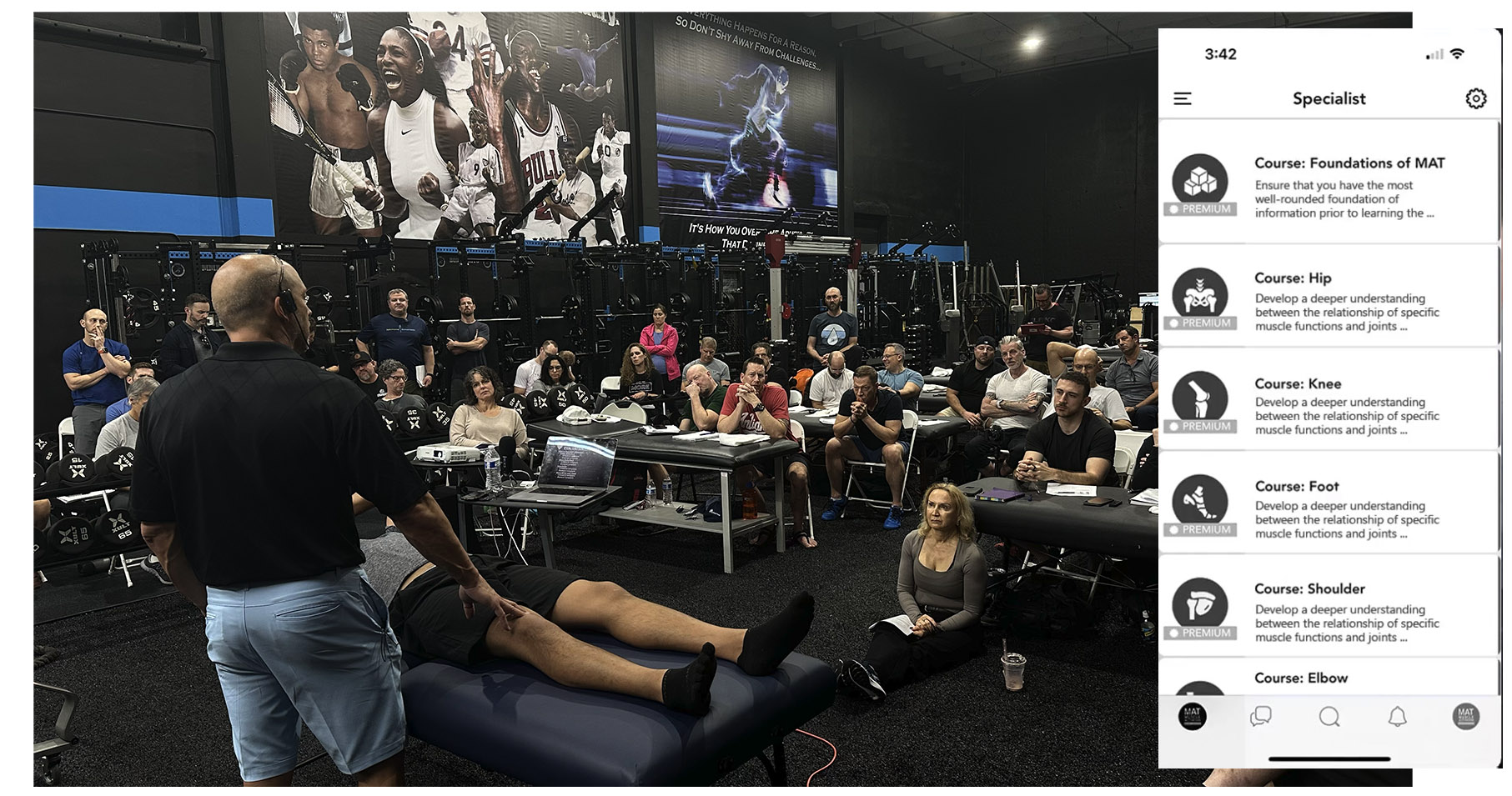Professional Development
Education Overview
MAT offers a clear path of professional development training for those looking to advance their ability to assess and treat the neuromuscular system in order to optimize health and human performance.
Our education includes introductory coursework fully online for the fitness professional, to multiple levels of certifications designed for individuals ready for an in-depth process to assess muscle inhibition and restore muscle function.
Our certifications include online coursework leading to in person certifying events. Transform your career with a proven system that delivers real results and gain a professional competitive advantage!
25+ Years
Certifications
We have multiple levels within our education continuum. Each level builds on the skillset of the previous level. To become a practitioner of MAT, individuals must achieve certifications at the Specialist level.
Level 1: Specialist
Within the Specialist Level, you will learn the full body integrated approach to assessing and correcting muscle imbalances with proprietary techniques to restore muscle function. Becoming proficient in this hands-on treatment process involves the ability to execute the techniques with precision.
Course Listing & Overview
Participants can achieve certifications within Lower Body, Upper Body, and Trunk and Spine as they work toward becoming a Full Body certified Practitioner.
Getting certified in MAT positions you as an expert in addressing muscle inhibition, a key problem often overlooked by traditional methods. Muscle inhibition occurs when muscles lose their ability to contract properly, leading to weakness, joint pain, restricted movement, and chronic injuries. The MAT system’s ability to pinpoint and correct these underlying muscle issues sets it apart from conventional therapies.
Our in-depth process teaches every division of every muscle in the body and how to evaluate for inhibited muscles. You will learn how to test and treat each muscle at the neuromuscular level, create activation that opens up range of motion and increases strength to allow the body proper healing and recovery. With MAT, you’ll have a systematic roadmap to improve muscle function and provide predictable outcomes for your clients.

Level 2: Mastery
- Login To View & Purchase
After completing the Specialist Certification, progress to the Mastery level coursework. This certification level dives deeper into advanced techniques and methodologies, allowing you to work with more complex cases and achieve greater results.
- Exclusive MAT Plus Offering Invite Only
Level 3: Elite
- Login To View & Purchase
This level is the Pinnacle of MAT education, including MATRx and MAT Athlete Certifications. The training in MATRx equips you with the tools to address chronic and severe muscle dysfunctions with confidence. In MAT Athlete, you learn to perform with quick, efficient and effective skills to enhance stress tolerance levels for higher levels of performance and recovery in athletic environments.
Education
Get Registered
Become A Practitioner
If you are looking to provide a more efficient and effective neuromuscular treatment process that addresses not just your client’s symptoms but the root causes of their muscle dysfunction, take our questionaire and start learning today!
Note: Becoming a certified MAT practitioner is your key to advancing your career and improving outcomes.
- Complete the questionnaire and register for your first MAT coursework and Specialist certification.
- Complete coursework and attend certification events in Specialist level subjects Lower Body, Upper Body, and Trunk and Spine as you work toward the Full Body Certification.
- Gain Full Body Certification. Advance your skills to perform a full body treatment, creating stability and restoring optimal muscle function.
25+ Years
Non-certifying Coursework
Learn The Principles Behind MAT
Certified MAT Practitioners
Testimonials
Unlike many certifications, MAT gives you the tools to achieve better client outcomes and fill the gaps left by other methods. Certified MAT practitioners often see a strong return on investment by attracting high-end clients and building referral-based businesses.





Questions & Answers
FAQs
What’s the difference between “Muscle Activation” and “Muscle Activation Techniques (MAT)”?
The 5-Step MAT Process
STEP 1: Comparative Assessment of Mobility (CAM)
The CAM is a precise measurement of limb motion, comparing movement from one side of the body to the other. This assessment helps identify potential muscle inhibition by highlighting differences in range of motion. The goal is to detect imbalances that indicate muscle dysfunction, not simply assess joint stability or tissue flexibility.
STEP 2: Active Muscle Contract and Sustain (AMC&S) Assessment
This step involves testing the muscle’s ability to contract and hold against resistance. The MAT Practitioner applies a specific force to see how well the muscle reacts. Unlike traditional muscle tests, this assessment focuses on neuromuscular responsiveness, not overall strength or relaxation.
STEP 3: Digital Force Application to Muscle Attachment (DFAMAT)
The MAT Practitioner applies targeted pressure directly to the muscle attachment points using specific techniques. This is not a massage or tissue release method; it’s designed to stimulate sensory receptors in the muscle, improving its contractile function. This unique application is what sets MAT apart from other manual therapies.
STEP 4: Recheck Muscle Function via AMC&S Test
After applying the DFAMAT technique, the therapist rechecks the muscle using the same AMC&S assessment to confirm that the muscle’s contractile ability has improved.
STEP 5: Recheck CAM for Improved Range of Motion
Finally, the MAT Practitioner re-evaluates range of motion using the CAM to see if the muscle inhibition has been resolved. This systematic process gives both the therapist and client clear feedback on whether the treatment was effective.
This step-by-step system is unique to MAT and provides a clear framework for assessing and improving muscle function. By focusing on muscle contractile capabilities, MAT offers a targeted approach that addresses the root causes of muscle dysfunction. The goal is not just to reduce symptoms but to correct the underlying issues, leading to lasting improvements in mobility, stability, and overall performance.
Is this just another certification that won’t make me any money?
It’s understandable to be cautious investing in a certification. However, MAT is not just another “Weekend-to-get-and-a-Weekend-to-forget” program—it’s a specialized skill set that fills a gap in the health and wellness industry. For over 25 years, MAT practitioners have become highly sought after in professional sports, rehabilitation facilities, and private clinics. MAT opens doors to lucrative opportunities by offering a non-invasive, hands-on approach to treating muscle dysfunction that clients value.
“MAT has provided more positive results to our clients than any other technique I have witnessed during my 20+ years as Physical Therapist.” Shannon Maixner, Physical Therapist and MAT Practitioner
Is MAT Certification worth the investment?
The cost of MAT certification might seem high at first, but the long-term benefits can far outweigh the initial investment. Many MAT therapists quickly see a return on investment by attracting clients who are willing to pay for specialized care that addresses issues other modalities haven’t resolved.
A significant portion of MAT clients are pained individuals who have tried multiple therapies like physical therapy, chiropractic care, and massage with limited to no success. They are seeking a return to their normal quality of life and are willing to invest in a solution that works. MAT fills this gap by offering a targeted approach that restores function, improves well-being, and delivers lasting results. Many therapists have built thriving, referral-based businesses by helping clients who are eager to regain their health and vitality.
If sales and marketing aren’t your strengths, don’t worry. With MAT, your results will do the talking. The effectiveness of MAT naturally generates referrals as clients experience real, immediate improvements. This approach reduces the need for aggressive marketing, allowing you to focus on your skill set while building a steady flow of clients through word-of-mouth.
“The R.O.I. is ridiculous if you take every course seriously and implement what you learn. It has been life-changing for me and my clients.” Eric Ferguson, MAT Practitioner, Austin, TX
What kind of clients will I be seeing?
Most MAT clients experience some level of pain or discomfort and have often tried other therapies like physical therapy, massage, or chiropractic care without lasting success. MAT focuses on correcting muscle inhibition, the root cause of many issues, rather than just addressing symptoms. This approach leads to quicker, more lasting results, with many clients experiencing noticeable improvements within 1-3 sessions.
Does MAT give me the ability to diagnose and treat pain?
No, MAT is not intended to diagnose or directly treat pain or any medical conditions. The primary goal of MAT is to improve muscle contractile efficiency and optimize movement. However, it’s important to understand that when muscle function is improved, clients may naturally experience a reduction or even elimination of pain. This doesn’t mean MAT is treating pain directly; rather, it’s addressing the muscle imbalances that can contribute to discomfort.
While most clients do find relief from pain as a by-product of better muscle function, MAT practitioners focus solely on restoring muscle activation and mobility—not on diagnosing or treating pain itself. If a client’s pain is rooted in a medical condition, they should work with licensed medical professionals, with MAT serving as a complementary approach.
In summary, MAT can play a crucial role in improving how your muscles work, which may reduce pain, but the process is not designed or intended to treat pain as a medical condition. This clear distinction allows MAT therapists to work effectively within their scope while providing real value to their clients.
Why Get Certified In MAT
Getting certified in MAT positions you as an expert in
addressing muscle inhibition, a key problem often overlooked by traditional methods. Muscle inhibition occurs when muscles lose their ability to contract
properly, leading to weakness, joint pain, restricted movement, and chronic injuries.
These inhibited muscles can no longer support the body as they should, forcing other muscles to overcompensate, creating further dysfunction and
imbalances across the body.
The MAT system’s ability to pinpoint and correct these
underlying muscle issues sets it apart from conventional therapies. As an MAT-certified specialist, you’ll learn how to systematically assess over 140
specific muscles, identify which ones are inhibited, and restore their function.
This means faster, more effective treatments for your clients, addressing not just symptoms but the root
causes of their dysfunctions.

